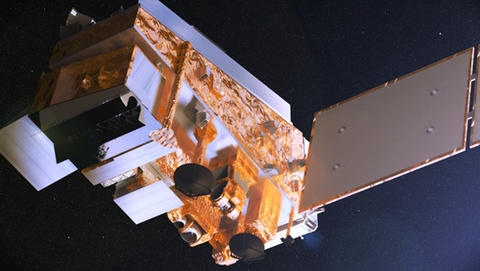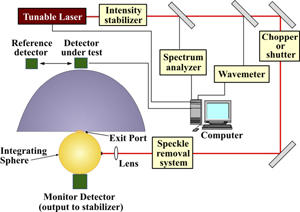
Artist's conception of the NPP satellite. The VIIRS instrument suite is at the top left of the image.
For NASA's Earth Observing System satellite fleet, sensor failure is not an option. The nation depends critically on the data from those satellites, orbiting hundreds of miles above the Earth's surface, to provide information about weather and climate variables including sea level and surface temperatures, as well as phenomena such as oil spills, plankton blooms, wildfires, volcanic ash, and deforestation.
So when project managers were completing work on the latest addition to the fleet—a minibus-size instrument array called the National Polar-orbiting Operational Environment Satellite System Preparatory Project, or NPP for short—they saw an opportunity to take advantage of a PML facility called Spectral Irradiance and Radiance Responsivity Calibrations using Uniform Sources (SIRCUS).
The NPP observatory, scheduled for launch on October 25, 2011, will make 14 orbits per day 512 miles above the Earth's surface, carrying five separate instruments to monitor the planet's surface, clouds, ozone levels, microwave emissions and more. The project is a partnership effort among NASA, NOAA, the U.S. Air Force, and the Department of Defense.
The largest and most complicated of NPP's instruments is the Visible Infrared Imaging Radiometer Suite (VIIRS), built by Raytheon Space and Airborne Systems, which will monitor 22 spectral bands from the near-ultraviolet through the visible and near infrared.
"VIIRS delivery to the NPP observatory occurred in January 2010," says Bruce Guenther of NOAA, the project lead for Sensor Data Records, "and fortunately VIIRS was not the final instrument delivered to the observatory. The benefit of this situation was that additional VIIRS testing could be accomplished without any slip to the NPP launch schedule—that is, it was off the critical path."

To perform that testing, the government team asked SIRCUS scientists Steve Brown and Keith Lykke to bring a portable version of their apparatus—called Traveling SIRCUS—to the Ball Aerospace production and test facility in Boulder, CO, where the NPP was being assembled and its components integrated.
SIRCUS employs continuously tunable lasers coupled into integrating spheres as spectral irradiance or radiance sources, and the team used that system to perform spectral recalibration of the VIIRS sensor while it was attached to the NPP Observatory.
Some aspects of the VIIRS sensor, however, called for a different kind of source. So the SIRCUS team also used a newly developed Flat Plate Illuminator (FPI), a broadband radiance reference/calibration source in which bundles of fiber-optic lines carrying various wavelengths are attached to a flat plate and diffuser. This design ameliorates some undesirable features of conventional integrating spheres for calibrating large-aperture sensors. The FPI radiating surface is 25 cm by 35 cm, and the device can be used in air or vacuum at a wide range of temperatures throughout the environmental testing process for instruments or spacecraft. The FPI went through three design stages, with the final version capable of producing usable radiance from 0.4 µm to 2.0 µm.
Previous testing of VIIRS at the component level in 2008 had raised concerns about the sensor's ability to meet the stringent accuracy requirements for the 20 year climate data record for ocean color, which is used to assess ocean health and carbon storage.
"The SIRCUS calibration campaign was a test of a new calibration paradigm, using tunable lasers in place of lamp-monochromator systems," Brown says. "The use of tunable lasers enabled a full system-level test—the first of its kind. The results greatly alleviated concerns about the performance of the instrument and gave enhanced confidence in the resultant data set."
The system-level calibration confirmed that the radiometer's filters cause small leaks of radiometric flux between sensor bands, a phenomenon known as crosstalk. However, the SIRCUS team determined that the amount of crosstalk is small enough that VIIRS scientists should be able to use the calibration results to make corrections in measurements made by VIIRS on orbit. Traveling SIRCUS was also employed to study the internal on-orbit calibration system used by VIIRS for the visible through shortwave IR bands.
According to NOAA's Guenther, "two key results from this test are expected to pioneer significant new research approaches for Ocean Color studies. The uncertainty of the VIIRS . . . center wavelength for the ocean color bands is reduced from half a nanometer to below 0.1 nm. The band-to-band relative radiometric accuracy is reduced to below 0.1 % from what is at least a few percent for traditional testing methods with VIIRS."

